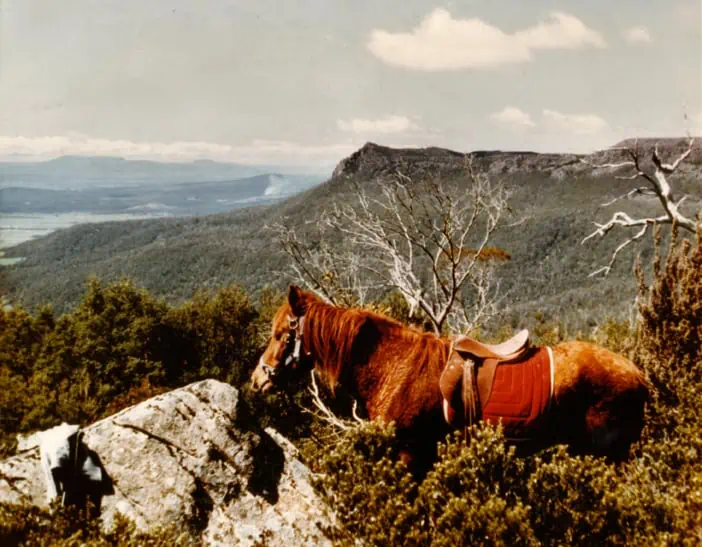Horseback Camping
Unlike the other camping experiences on this site, horseback camping is very special. This is because transport is not some inanimate machine but a living, breathing, thinking animal. For those of you who have been fortunate enough to have a horse, you will appreciate the relationship and bond one can develop with a horse.

My earliest recollection of riding is from a circus that came to Bullfinch when I was about six years old, and I volunteered from the crowd to ride bareback (no saddle) a circus horse. The ringmaster wasn’t going to make it that easy, though, and I was to ride a lap around the ring, standing on the horse. For my effort, I received 2 pounds (yes, it was before the currency pound-to-dollar conversion in Australia).

Horse Muster
Yamarna Station
We had several working horses on our property, and as a child, it was my job to catch them each morning for the stockmen. This involved getting up around 3.30 am and tracking the horses to where they had been grazing since their release the night before.
Cobber was an old trotter that my father had saved from the knackery, and he wore a bell around his neck, which was supposed to help locate their whereabouts on clear, still mornings. Cobber was often a little help, though. He would stand dead still, so the bell wouldn’t jingle, and I would have to follow tracks and gauge the freshness of manure droppings to find them.
The horse paddock was over a mile square; depending on where they were, this exercise could take an hour or so. Once located, I would catch the quietest horse and muster the remainder, driving them back to the stockyards where the stockmen were waiting impatiently to saddle up for the day’s work.
Blondie
When I was nine, my father bought my first horse, Blondie (pictured above). A young skewbald mare that had a nasty streak, and we didn’t get on. She was as quiet as pie with my father, but from the outset, she would bite me when I mounted (I always had large blue-black bite marks) and take any opportunity to gallop under low-hanging branches trying to dislodge me. Her other favourite trick was to wait until I was seated and relaxed; then, she would start bucking, trying to unseat me. Anyway, it was all a good experience and preparation for horseback camping.
Chiaroscuro

First Camping
My first significant horseback camping trip occurred when I was about nine or ten. Richard Cotterill and I saddled up, and with a pack horse in tow, we rode to Minnie Creek and back, which ended up a six-day ride. Unfortunately, a dingo had died in the waterhole at Minnie Creek, floating and disintegrating into a putrid mess. We spent the day boiling water for the horses and mixing soup cubes so we could drink the foul-tasting fluid. Of course, camping was a way of life even at that early age and something we frequently did, but we spent weeks planning our horseback camping trip. The key to any extended camping trip is thorough planning and thinking through contingencies for various possibilities.
Each night we hobbled and put bells on the horses. If you are miles from anywhere, the last thing you want is for your horses to disappear, and hobbling allows them to graze but stay close. If you are backpacking, you don’t overload your pack. The same principle exists when horseback camping, don’t overload your friends by taking superfluous equipment.

Studies have shown horses can retain weed seeds in their gut for up to 14 days, and these can then germinate in manure. On the horses we rode, we had two saddlebags, a quart pot and a bedroll across the back. This simple configuration can provide you with enough food for weeks.
Tasmania
In the 1980s I spent many weeks camping on the Central Plateau with my horse ‘Fire’. He was as tough as nails. I would lead him up the 2,000 feet incline on a narrow track to the Plateau. I rarely rode him on the Plateau as it is full of treacherous holes but he carried our supplies.
Safety
Horseback camping today is very different from that of years gone by, and we have different expectations and responsibilities. It is sensible to carry a first aid kit for horse ahorsesder. Key members of a party should be trained in first aid and have basic veterinary first aid skills. The use of riding helmets is encouraged, particularly for children. Helmets are generally available as part of any commercial horse riding tour.
It is also essential to check all saddlery equipment before commencing a horseback camping trip to ensure there are no faults and that appropriate safety gear is present, e.g. surcingles on stock saddles, breastplates and cruppers for the rugged country. Remember to take spare ropes, horseshoes and shoeing gear.
Some other items of equipment that are essential on any horseback camping trip are:
torch
water
space blanket
ample food
compass
topographic map
raincoat
horse bandages
plastic bag for rubbish
Let someone know before you go by telling a friend your route and expected time of return. If an emergency develops, one of two riders should go for help while the others stay with the injured or ill person. Keep the patient warm and monitor their condition.
Horseback camping is a beautiful experience. Below is a picture taken along the Western Tiers, where I rode and camped for over two weeks in the Tasmanian Highlands.
Other Experience – Horseback Camping
Horseback Riding – by Bel Black
Horse Drawn Caravan – by John and Thea Verhoeckx

